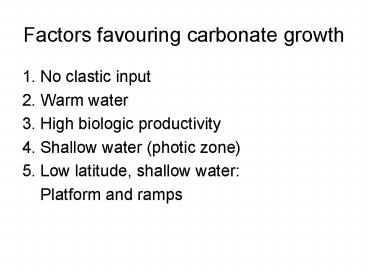Factors favouring carbonate growth - PowerPoint PPT Presentation
1 / 11
Title:
Factors favouring carbonate growth
Description:
In a prograding (building towards the sea) system (like our carbonate factory in ... fraction comes from storms which 'swash' coarser material far from its usual ' ... – PowerPoint PPT presentation
Number of Views:24
Avg rating:3.0/5.0
Title: Factors favouring carbonate growth
1
Factors favouring carbonate growth
- 1. No clastic input
- 2. Warm water
- 3. High biologic productivity
- 4. Shallow water (photic zone)
- 5. Low latitude, shallow water
- Platform and ramps
2
Walthers law
- In a prograding (building towards the sea) system
(like our carbonate factory in Bar al-Hikman) we
find in a vertical sequence reef-facies placed
on top of upper slope facies, upper slope facies
placed on top of lower slope facies etc. In
nature we find that reefs are situated next to
the upper slope and the upper slope is situated
next to the lower slope. This is what Walther
formulated as a law. (He assumed continious
deposits, i.e, no erosion).
If this is a prograding system (see text) you
would in a vertical succession see B on top of C
and A on top of B
3
Example of carbonate factory
Shelf margin
Upper slope
Lower slope
Basin
Shore zone
Sabkha
Lagoon
4
Basin
- Does not belong to the carbonate factory per ce,
but the basin is filled with products created by
the factory.(i.e gets its input from the factory)
as well as from microorganisms living in the
ocean. (These m.o secrets carbonate). - Below storm wave base (SWB)? There is no flow
regime in the basin? small particles like
carbonate mud (who would elsewhere be kept in
suspension) settles on the basin floor. - Both siliciclastics and carbonate turbidites
associated with basin floor fans occur, but is
very fine-grained.
5
Lower slope
- Is above the storm weather base
- Mud layers deposited because of low energy
regime - Turbidite deposits mostly fine sediment fraction
and low channel relief because the turbidites are
dying out towards the basin (far from the basin ?
only fine particles still suspended). Some extra
large turbidites may take coarse material further
out than usual giving this fraction in some of
the turbidite deposits. - The coarse fraction comes from storms which
swash coarser material far from its usual
habitat, which is further up the slope. - Rocks that form from this geomorphic environment
could be packstones, wackestones and mudstones.
Back
6
Upper slope
- The upper slope is located right below the reef
(or the shelf margin), and gets its input from
wave break-off and/or erosion of the reef/shelf
margin. - The products of the erosion is transported to the
upper slope by mega breccia debris flows and
coarse grained siliciclastic and carbonate
turbidites. - We also find algal mounds (lumps created by/with
algae)in the upper slope along with pack- wacke-
and mudstones.
Back
7
Shelf margin
- High energy flow regime (subjected to waves and
tidal currents) ? reef deposistion of coarse
sediment fraction - Reef
- waveresistant framework (formed by carbonate
secreting organisms) - Components
- Framework organisms
- Internal sediments
- Bio eroders
- Cement
- Rocks formed from this geomorphic environment can
be grainstone, bindstone and packstone
Typical carbonate reef
Back
8
Lagoon
- Protected by reefs or barrier islands.
- Influenced by tidal- and storm regimes.
- A lot of biologic activity in form of
brachiopodes (small crabs),algae
mats,sulfate-bacterias etc. - Could be a very good source for H.C, but is
seldom preserved.
Lagoon, BarAl Hikman, Oman
Back
9
Shore zone
- Influenced by both wind and waves (high flow
regime) ? mostly homogenous material (beach sand
and other fragments from the carbonate factory
eolian dunes) - Storm deposits high up on the beach (from waves
throwing material higher up than usual) - The shore zone forms a crest (natural high) and
we often have a sabkha or a lagoon behind it. - This geomorphic environment often gives
grainstones (contains no mud)
Back
10
Sabkha
- Sabkha means salt flat.
- We find sabkhas in areas where the evaporation
far exceeds the average rainfall pr year. - We separate between coastal and continental
sabkhas, where coastal sabkhas are influenced by
marine waters and continental is influenced by
freshwater aquifers. - When water evaporates in a dry climate, salt is
precipitated. As the space diminish, the salt
crack in hexagonal shapes and grows towards
eachother.
Back
11
Dunhams classification
Back































